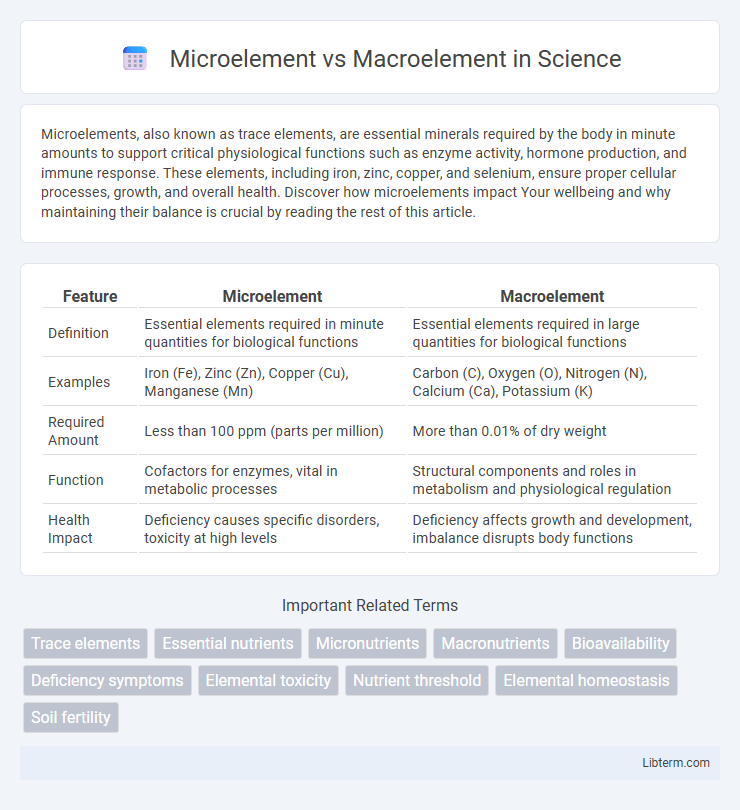Microelements, also known as trace elements, are essential minerals required by the body in minute amounts to support critical physiological functions such as enzyme activity, hormone production, and immune response. These elements, including iron, zinc, copper, and selenium, ensure proper cellular processes, growth, and overall health. Discover how microelements impact Your wellbeing and why maintaining their balance is crucial by reading the rest of this article.
Table of Comparison
| Feature | Microelement | Macroelement |
|---|---|---|
| Definition | Essential elements required in minute quantities for biological functions | Essential elements required in large quantities for biological functions |
| Examples | Iron (Fe), Zinc (Zn), Copper (Cu), Manganese (Mn) | Carbon (C), Oxygen (O), Nitrogen (N), Calcium (Ca), Potassium (K) |
| Required Amount | Less than 100 ppm (parts per million) | More than 0.01% of dry weight |
| Function | Cofactors for enzymes, vital in metabolic processes | Structural components and roles in metabolism and physiological regulation |
| Health Impact | Deficiency causes specific disorders, toxicity at high levels | Deficiency affects growth and development, imbalance disrupts body functions |
Introduction to Microelements and Macroelements
Microelements, also known as trace elements, are essential nutrients required by organisms in minute quantities, typically less than 100 mg per day, and include iron, zinc, copper, manganese, and iodine. Macroelements, or major nutrients, are needed in larger amounts, often measured in grams per day, and consist of elements such as calcium, potassium, magnesium, phosphorus, and sulfur. Both microelements and macroelements play crucial roles in physiological processes, enzyme functions, and structural integrity within plants, animals, and humans.
Definition of Microelements
Microelements, also known as trace elements, are essential nutrients required by organisms in minute quantities, typically less than 100 milligrams per day for humans. These elements include iron, zinc, copper, manganese, and selenium, playing vital roles in enzymatic reactions, hormone production, and cellular functions. Unlike macroelements such as calcium, nitrogen, and potassium that are needed in larger amounts, microelements are critical for maintaining metabolic balance and overall health despite their low concentration.
Definition of Macroelements
Macroelements, also known as macronutrients, are essential chemical elements required by organisms in large amounts to support vital biological functions such as growth, metabolism, and structural integrity. Common macroelements include carbon, hydrogen, oxygen, nitrogen, phosphorus, and sulfur, which collectively constitute the majority of cellular material. These elements differ from microelements or trace elements, which are needed in minute quantities but are equally crucial for enzymatic activities and physiological processes.
Key Differences Between Microelements and Macroelements
Microelements, also known as trace elements, are nutrients required by organisms in minute quantities, typically less than 100 milligrams per day, including iron, zinc, and copper. Macroelements are necessary in larger amounts, generally exceeding 100 milligrams daily, and include elements like calcium, potassium, and nitrogen essential for structural and metabolic functions. The key difference lies in their required quantities and physiological roles, where macroelements primarily support structural components and osmotic balance, while microelements are critical for enzymatic activities and electron transport.
Biological Functions of Microelements
Microelements, also known as trace elements, play crucial biological roles by serving as cofactors for enzymes, facilitating electron transport, and supporting immune system function. Unlike macroelements such as calcium and potassium that are required in large amounts for structural and fluid balance roles, microelements like iron, zinc, and copper are vital in small quantities for processes such as oxygen transport, DNA synthesis, and antioxidant defense. Deficiencies in microelements can lead to impaired metabolic activities, weakened immunity, and developmental disorders, highlighting their essential yet minute presence in living organisms.
Biological Functions of Macroelements
Macroelements such as calcium, potassium, and magnesium play crucial roles in maintaining physiological processes including nerve impulse transmission, muscle contraction, and enzyme activation. These elements are required in larger amounts compared to microelements and are essential for structural components like bones and cellular homeostasis. Deficiency or imbalance of macroelements can lead to significant disruptions in metabolic functions and overall health.
Dietary Sources of Microelements
Microelements, also known as trace elements, are essential nutrients required by the body in minute amounts, including iron, zinc, copper, selenium, and iodine. Rich dietary sources of microelements include seafood, nuts, seeds, whole grains, and leafy green vegetables, which provide vital minerals for enzyme function, immune support, and metabolic processes. In contrast, macroelements such as calcium, potassium, and magnesium are needed in larger quantities and are primarily obtained from dairy, fruits, and vegetables.
Dietary Sources of Macroelements
Macroelements, essential for bodily functions, include calcium, magnesium, potassium, sodium, phosphorus, and sulfur, commonly found in foods such as dairy products, leafy greens, nuts, bananas, salt, meat, and legumes. These elements support bone health, fluid balance, nerve transmission, and muscle contraction. Consuming a balanced diet rich in these foods ensures adequate intake of macroelements necessary for optimal metabolic processes and overall health.
Deficiency Symptoms of Microelements vs Macroelements
Deficiency symptoms of microelements such as iron, zinc, and copper typically include chlorosis, stunted growth, and poor flowering due to their role in enzyme activation and photosynthesis. Macroelements like nitrogen, phosphorus, and potassium deficiencies often result in more visible symptoms including leaf yellowing, necrosis, and reduced root development because they are required in larger amounts for fundamental plant processes. Identifying specific deficiency symptoms helps in targeted fertilization, optimizing plant health and yield.
Importance of Balanced Microelement and Macroelement Intake
Balanced intake of microelements such as iron, zinc, and copper alongside macroelements like calcium, potassium, and magnesium is crucial for maintaining optimal physiological functions, including enzyme activity, nerve transmission, and bone health. Deficiencies or excesses in either category disrupt metabolic processes and increase the risk of chronic diseases like osteoporosis, anemia, and cardiovascular disorders. Effective nutritional strategies emphasize proportional consumption of both microelements and macroelements to support cellular function and overall well-being.
Microelement Infographic

 libterm.com
libterm.com